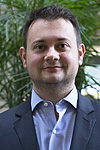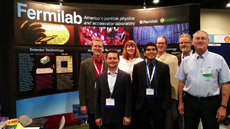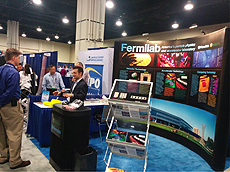National Innovation Summit
 |
|
Aaron G. Sauers
|
Aaron G. Sauers, patent and licensing agent, wrote this column.
Will Fermilab technology drive the next generation in sneaker design, find its way into your next cell phone or pave the way to superior roads?
The Office of Partnerships and Technology Transfer, IARC and technical staff members represented Fermilab and its cutting-edge technologies at the National Innovation Summit and Showcase from June 15 to 19, giving industry leaders a glimpse of the future.
The 2015 summit took place near Washington, D.C., and was co-located with the National SBIR/STTR Conference and the TechLink World Innovation Conference and Expo.
It was an excellent opportunity to meet with people from small businesses, Fortune 500 companies, and angel and venture capitalists. The event allowed for the international, policy and economic development communities to network.
OPTT submitted a total of six patent-pending technologies to present at the summit:
1. Injection Locked Magnetron with Phase and Amplitude Control: A technology that enables use of lower-cost, high-efficiency magnetrons (devices commonly used in microwave ovens) for radio-frequency power sources, where tight vector control is required.
2. Highways: A truck-mounted electron accelerator that can be used for in situ treatment of freshly laid asphalt, turning it into a tougher, longer-lasting material.
3. Pixelated Detector: A large-area, highly segmented camera system with pixels capable of handling signals of up to five orders of magnitude of dynamic range and in situ storage of images acquired at high speed.
4. SEUSS (Single Event Upset Suppression System): A circuit latch that can be configured in a number of ways familiar to electronic engineers that is resistant to malfunctions caused by electromagnetic radiation.
5. VIPRAM: A high-speed pattern recognition system using 3-D integrated circuits.
6. WireCAP: a novel packet capture engine for commodity network interface cards in high-speed networks.
Each technology was featured on the booth and on its own "technology card," which included a synopsis, the inventor's vision for the technology and its potential for market impact.
Keep in mind, we were competing for the crowd's attention against the backdrop of the National Harbor, a giant air-conditioned Ferris wheel and a Peeps mobile. (A Peeps and Company Store, devoted entirely to the marshmallow candy, was located steps from the conference center, with the namesake car parked out front.)
Fortunately, we had our own candy (Smarties, naturally), and a 3-D-printed scale model of a compact SRF accelerator at the booth, which attracted lots of visitors and served as a good conversation-starter.
Robert Kephart, IARC director and inventor of the Highways technology, delivered a presentation on compact SRF accelerators that Monday as part of the Technical Program Advanced Manufacturing track.
Engineer Brian Chase gave a presentation on his Injection Locked Magnetron with Phase and Amplitude Control invention on Tuesday as part of the Business Program, Energy and Efficiency session; this invention was also selected for a 2015 TechConnect National Innovation Award.
Tom Kroc, Accelerator Division liaison of IARC, presented a poster on industrial applications for accelerators in the same track on Wednesday. Jim Hoff, inventor of SEUSS and VIPRAM, assisted in detailed technical discussions with a number of companies.
Everyone in attendance took turns staffing the booth and made valuable contacts for Fermilab. These are exciting times for our burgeoning technology transfer operation.
Will a little yellow Peeps mobile one day coast down a Fermilab roadway? Perhaps.
Steer clear of the magnetrons, little marshmallow. Steer clear of the magnetrons.
 |
Fermilab was well-represented at the recent National Innovation Summit and Showcase near Washington D.C. Front row, from left: Aaron Sauers (OPTT), Miguel Marchan (WDRS), Bob Kephart (IARC). Back row, from left: Tom Kroc (AD), Cherri Schmidt (OPTT), Jim Hoff (PPD), Brian Chase (AD). Photo: Sean Todd, OCOO |
 |
The Fermilab booth touted the myriad technologies developed at the laboratory. Photo: Miguel Marchan, WDRS |
|